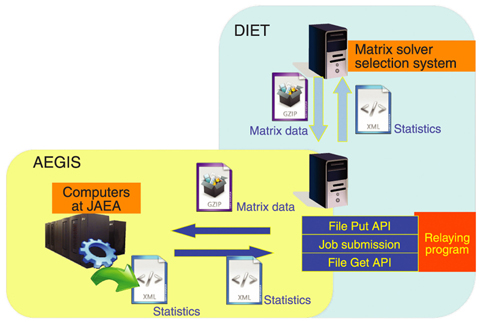
Fig.12-5 Illustration of IMAGINE system

Fig.12-6 Outline of matrix solver selection system
We have developed the Atomic Energy Grid Infrastructure (AEGIS), which allows us to carry out large-scale numerical simulations in the atomic energy field, e.g. seismic analysis of an entire nuclear power plant, since it enables supercomputers situated all over the world to work together. In this study, we developed an application programming interface (API) which allows us to run programs on other supercomputers with just a small modification of the program. Here we introduce two case examples of AEGIS use.
IMAGINE (Fig.12-5) is a dose calculation system being developed by the Nuclear Science and Engineering Directorate of JAEA, for X-ray cancer treatment. To decide the best irradiation point and strength considering the influence on both cancer tissue and normal organs, IMAGINE performs Monte Carlo computation. Since the size of the Monte Carlo calculation can be large, we attempted to use several supercomputers located far from each other, to shorten the total calculation time, using our API.
We won an incentive award from FUJITSU user forum on this study.
In this study, we are developing the matrix solver selection system that selects the most appropriate linear equation solver for one's problem from among those in Japanese and French computers (Fig.12-6). Since a linear equation solver usually the part of a simulation consuming the most time and memory, we must select a solver suited to the specific task for speed up or accuracy improvement of simulation. Since the selection system finds the linear solver best suited to solve the equations in question, increasing the number of available linear solvers will tend to result in a more suitable solver. In order to achieve this increase, we established collaboration between AEGIS and DIET, which is the French grid infrastructure. Consequently, many solvers installed only in Japan or French computers become available to the other country through this selection system.
The present study was conducted as one of the activities promoting strategic international cooperation in science and technology of the Japan Science and Technology Agency (JST).